The pages of our site provide a very conditional classification of types of woodcarving, which seems to us as close to the truth as possible.
Flat serrated thread
A characteristic feature is the flat main background, into which elements are embedded, i.e. all thread elements are below the background level.
- contour carving is obviously the simplest carving that gave rise to all other types.
- stapled (nail-like) carving - can be considered as a subspecies of contour, since it is not particularly difficult. The pattern is created various options combinations of brackets different in direction and size - semicircular notches on a flat background.
- black-gloss carving(carving on black lacquer) - the workpiece is covered with black lacquer or paint, and then lines are cut on it. This is how the pattern is created. The characteristic game of contrast sometimes conveys interesting stories.
- geometric carving - basic elements - geometric shapes are obtained from a multiple combination of pegs and pyramids.
relief carving
A characteristic feature is that the main background is at the level of the picture or significantly below it. The carved elements are not cut into the background, as in the types of flat carving, but, on the contrary, rise above the background.
- relief carving- background at the level of the drawing (sometimes such a carving is called flat-relief with a pillow background)
- deaf- (sometimes such a carving is called flat-relief with a selected background) the background is selected, but how deep in relation to the pattern determines the subspecies of this carving
- bas-relief- not very deep, the drawing has a low relief
- high relief- much deeper, the pattern has a high relief
- - originated in the village of Kudrino of the Abramtsevo estate, therefore it has both a single and a double name. It is characterized by a special pattern that cannot be confused with any other.
- Islimi is a special carving, characterized by deep selection and embossing of the background. Distributed mainly in Central Asia.
- Tatyanka is a relatively fresh type of carving, invented at the end of the 20th century by our compatriot. The carving got its name in honor of the author's wife. The carving is relatively simple and very saturated with plant elements. If desired, it is available to carvers of all ages, there are no restrictions.
through thread
From the name it is clear that such a thread has through holes, mainly parts of the background are removed. For the apparent airiness, lightness and similarity with lace, it often bears the name openwork carving. It has two slightly different types:
- slotted- sections of the background are cut with chisels
- sawn- sections of the background are sawn with a saw or a jigsaw (in this case, we can talk about
(Appendix 1)
Situation
Schoolchildren had to create household items, such as decorative and applied wood products with artistic processing.
When doing this work, the students sawed out parts for their products from plywood, but they did not know what to do next, what kind of artistic processing to choose.
The children needed to solve this problem.
Task: Find the best solution for this situation and how to implement it.
Specification of the task:
Determine the main types artistic processing wood.
· Justify what type of artistic wood processing is the simplest and most acceptable for this task.
Job context:
Select and study slotted thread information, necessary tools and fixtures, as well as about the methods of slotted threads.
Additional Information.
1. Artistic wood processing – ancient craft. In wooden architecture, people found usefulness and beauty. He decorated the house with carved wooden products, and the house decorative carving, made toys, wooden utensils and souvenirs.
http://pandia.ru/text/78/016/images/image002_4.jpg" align="left" width="293" height="207 src=">.jpg" align="left" width="372 "height="320 src=">
http://pandia.ru/text/78/016/images/image006_3.jpg" align="left" width="139" height="204">
http://pandia.ru/text/78/016/images/image008_2.jpg" alt="(!LANG:Picture 128 of 14126" align="left" width="108" height="172 src=">!} 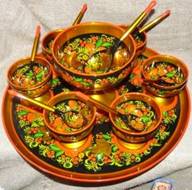 .jpg" align="left" width="312" height="240 src="> different kinds mosaics: inlay, intarsia, marquetry, beautifully decorating furniture with it.
.jpg" align="left" width="312" height="240 src="> different kinds mosaics: inlay, intarsia, marquetry, beautifully decorating furniture with it.
Woodworking" href="/text/category/derevoobrabotka/" rel="bookmark">wood processing along with sawing and turning).
There are many types of carving. Among them, the most widespread are:
- flat notched; geometric; slotted.
a) FLAT THREAD It is characterized by the fact that its basis is a flat background, and the carving elements go deep into it, that is, the lower level of the carved elements lies below the background level.
http://pandia.ru/text/78/016/images/image014_2.gif" width="216" height="177">
There are several subspecies of such a thread:
align="left" width="132" height="130 src=">The main element of the thread is a bracket (outwardly it looks like a trace left by a fingernail when pressing on any soft material, hence the name nail-shaped) - a semicircular notch on a flat background. Such a notch is made with a semicircular chisel in two steps: first, the chisel is deepened into the tree perpendicular to the surface, and then at an angle at some distance from the first notch. The result is the so-called bracket.
b) GEOMETRIC CARVING- is also a type of flat notched thread.
This is one of the most ancient and widespread types of woodcarving. Due to the ease of implementation, in the second half of the 17th century in Russia, it was most widely used. It is made in the form of various notches that form a geometric ornament on the plane, hence its name "geometric".
http://pandia.ru/text/78/016/images/image019_0.jpg" alt="(!LANG:Photo" align="left alt="width="50 height=130" height="130">.jpg" alt="Photo types of woodcarving" align="left" width="189" height="112"> рис. 2!}
Wooden houses" href="/text/category/derevyannie_doma/" rel="bookmark">carved wooden houses. wooden houses of any income, conquered with filigree ligature handmade, intricately woven into such amazing patterns that it is difficult to even imagine that they are really created by human hands. Until now, individual samples of wood carving, reminiscent of lace plexuses, have survived and come down to us.
http://pandia.ru/text/78/016/images/image024_2.jpg" align="left" width="276" height="184 src="> slotted or Propilnaya (through openwork) thread - view decorative processing wood, in which the patterns outlined on a flat surface are cut with a jigsaw or twist saw. In sawn carving, decorativeness is achieved by an openwork mesh. The patterns of sawn wooden strips decorating the facades of houses are beautiful. Curls of a through floral or geometric ornament look great against the background of the wall.
Saw thread - is the simplest. This job does not require material costs, and in terms of simplicity and ease of execution, it is the most accessible craft for any student.
Many beautiful products can be made from plywood and decorated with sawn carvings: furniture, kitchen utensils, candlesticks, shelves, boxes, etc.
http://pandia.ru/text/78/016/images/image026_2.jpg" align="left" width="221" height="164 src=">.jpg" align="left" width="165 "height="216 src=">
http://pandia.ru/text/78/016/images/image030_2.jpg" align="left" width="156" height="98 src=">
http://pandia.ru/text/78/016/images/image032_1.gif" alt="2" align="left" width="212" height="184 src="> Sawing carving on plywood is usually cut with a jigsaw , which consists of a frame with a handle, upper and lower clamping screws.A narrow and thin steel file is stretched and fastened between the clamping screws with the teeth tilted towards the handle.
An eccentric clamp is used to tighten the frame before attaching the file. After fixing the file with screws, the eccentric clamp is removed. The file is stretched under the action of the frame.
http://pandia.ru/text/78/016/images/image034_2.jpg" alt="(!LANG:lobzik_1" align="left" width="244" height="180 src="> Так же для работы необходим специальный выпиловочный столик, который крепят в заднем зажиме верстака.!}
Performance of work" href="/text/category/vipolnenie_rabot/" rel="bookmark"> performance of work, the movement of the file must be carried out for its entire length.
If the file jams in the part, you need to slightly turn the file to the side and remove the delay, or release the upper end of the file and remove it from the cut.
To cut out the inner contours of the pattern, a hole is drilled in plywood, in
which is inserted freed from the upper clamp, the end of the file. To insert the free end of the file into the prepared hole, it is necessary to fix one arc of the jigsaw in a vice, then pass the end of the file into the hole of the part, and, squeezing the arcs of the jigsaw, secure the file with a clamp. Do this carefully so as not to break the nail file. After sawing a hole, the nail file is removed in the same way.
In Russia, woodcarving was called carving. The drawing is a sign, the words were also used: vyzorochye, patterned.
Ancient images of grass patterns - in the Byzantine style. Not earlier than the 16th century, fryashchina (Fryazh herbs) appeared - herbal decorations borrowed from Italy.
anonimus, CC BY-SA 3.0In the second half of the 17th century, German carving appeared in Russia, figured, with Gothic motifs. In 1660, the royal dining room, designed by the German architect Dekenpin, was decorated with this carving.
Resi were painted with bright colors, sometimes covered with gold leaf.
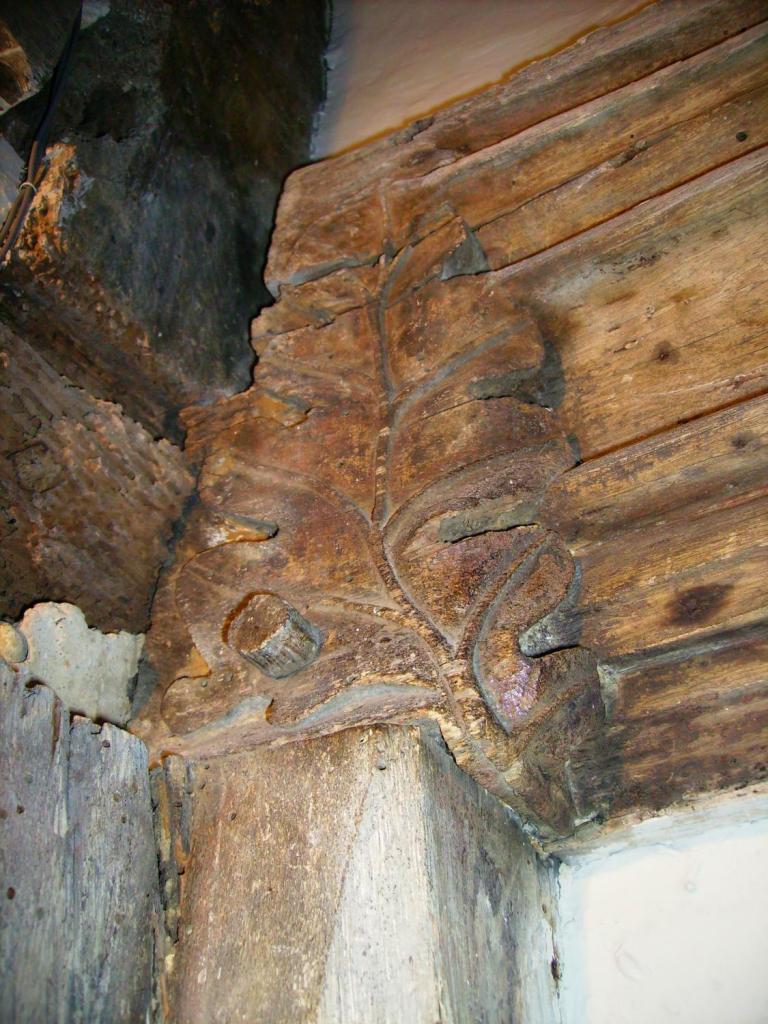 Graham Bould, CC BY-SA 3.0
Graham Bould, CC BY-SA 3.0 modern carving
Now wood carving does not have a strict classification, since in the same product they can be combined different types threads.
It is conditionally possible to distinguish the types of thread:
- through thread (this includes saw and slotted thread)
- blind thread (all subspecies of embossed and flat notched thread)
- sculptural carving
- house carving (it is a separate direction, since it can combine all three of the above types).
- Chainsaw carving (Performing mainly sculptural carving using only a chainsaw.)
The conditional classification of thread types is as follows:
through thread
It is subdivided into proper through and consignment note, has two subspecies:
- Slotted carving - (through sections are cut with chisels and chisels)
- Saw thread (actually the same, but such sections are cut with a saw or jigsaw).
A slotted or sawn carving with a relief ornament is called openwork.
Flat serrated thread
Flat carving is characterized by the fact that its basis is a flat background, and the elements of the thread go deep into it, that is, the lower level of the carved elements lies below the background level. There are several subspecies of such a thread:
- contour thread - the simplest, its only element is a groove. Such grooves-grooves create a pattern on a flat background. Depending on the chosen chisel, the groove can be semicircular or triangular. The semicircular one is cut with a semicircular chisel, and the triangular one is cut with a corner cutter, an angular chisel or a knife in two steps.
- stapled (nail-like) carving - the main element is a bracket (outwardly it looks like a trace left by a nail when pressed on any soft material, hence the name nail-like) - a semicircular notch on a flat background. Such a notch is made a semicircular chisel in two steps: first, the chisel is deepened into the tree perpendicular to the surface, and then at an angle at some distance from the first notch. The result is the so-called bracket. A set of such brackets of different sizes and directions creates a picture or its individual elements.
- geometric carving:
- trihedral thread
- two-sidedwashing thread
- four-sided washout thread
- black lacquer carving - the background is a flat surface covered with black lacquer or paint. How grooves are cut in the contour carving on the background, from which the drawing is built. Different groove depths and their different profiles give interesting game chiaroscuro and contrast of the black background and light cut grooves.
relief carving
Relief carving is characterized by the fact that the carving elements are above the background or on the same level with it.
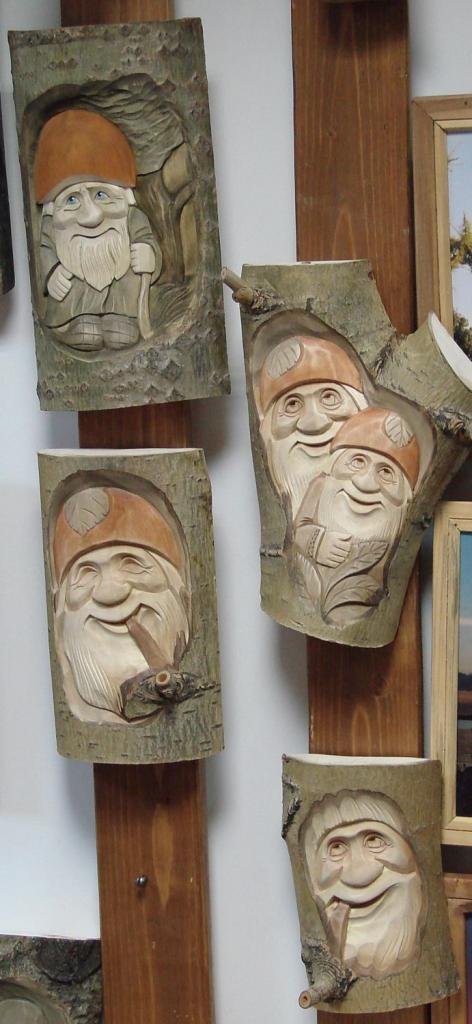 Sergeev Pavel, CC BY-SA 3.0
Sergeev Pavel, CC BY-SA 3.0 As a rule, all carved panels are made in this technique. There are several subspecies of such a thread:
- flat-relief carving with a pillow background - can be compared with contour carving, but all the edges of the grooves oval, and sometimes with varying degrees of steepness (more sharply from the side of the picture, gradually, gently sloping from the side of the background). Due to such littered contours, the background seems to be made of pillows, hence the name. The background is on the same level as the drawing. Relief carving with selected background - the same carving, but only the background is selected with chisels one level lower. The contours of the picture are also oval.
- Abramtsevo-Kudrinskaya carving (Kudrinskaya) - originated in the Abramtsevo estate near Moscow, in the village of Kudrino. Vasily Vornoskov is considered the author. The carving is distinguished by a characteristic "curly" ornament - curly garlands of petals and flowers. The same characteristic images of birds and animals are often used. As well as flat-relief, it happens with a pillow and a selected background.
A distinctive feature is the presence of sculpture - images of individual figures (or groups of figures) of people, animals, birds or other objects.
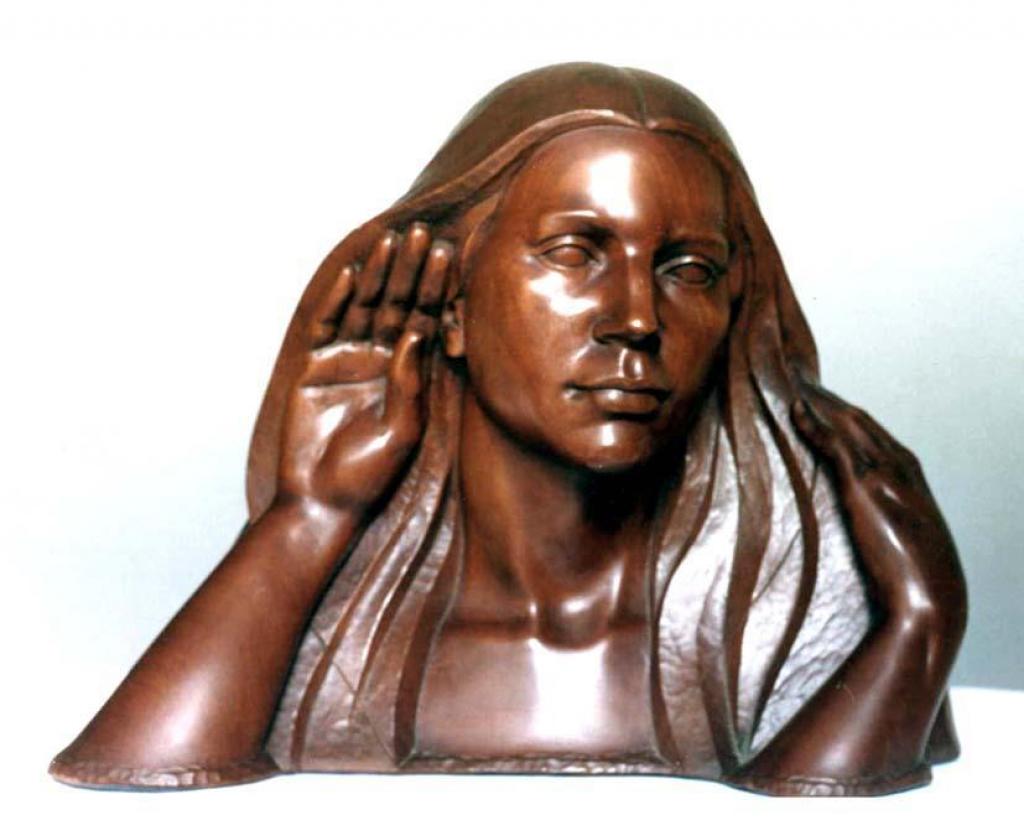 User:MarisaLR , GNU 1.2
User:MarisaLR , GNU 1.2 In fact, it is the most difficult type of carving, since it requires the carver to have a three-dimensional vision of the figure, a sense of perspective, and maintain proportions.
About tools
There is no universal tool for wood carving. This craft involves the use of a whole range of different knives, chisels, chisels, vices, cutters and hacksaws.
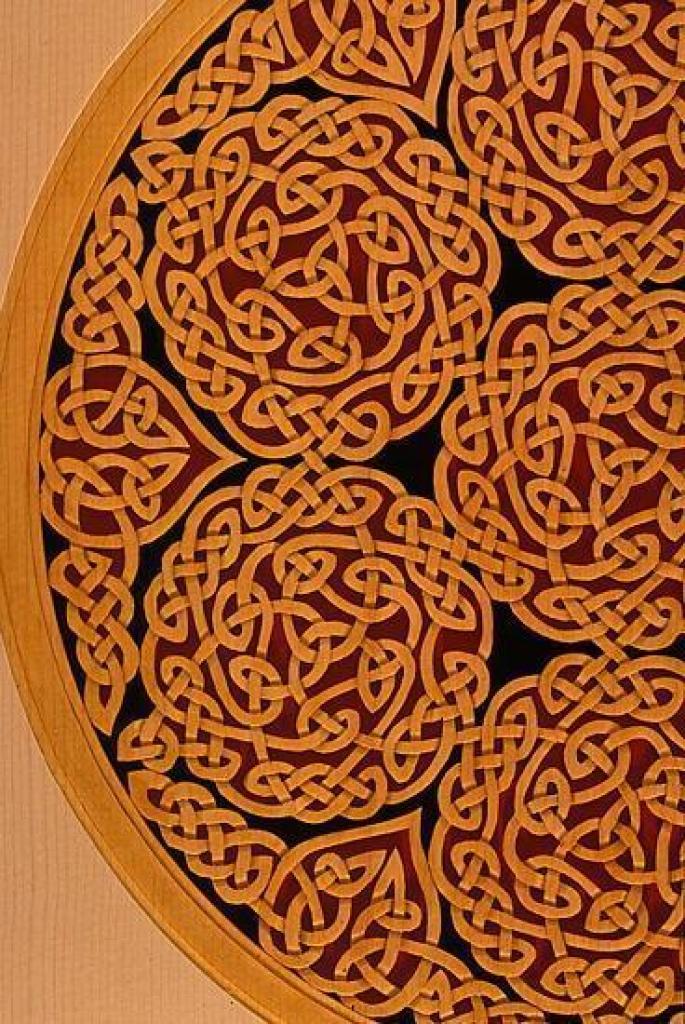 Ervinsomogyi, CC BY-SA 3.0
Ervinsomogyi, CC BY-SA 3.0 The main requirement is that all tools must be of excellent quality so that you can easily perform carving work of any complexity.
The cutting tool should be made of good steel, light and comfortable, perfectly sharpened so that the wood is cut like butter, it should be kept in perfect condition.
Photo gallery
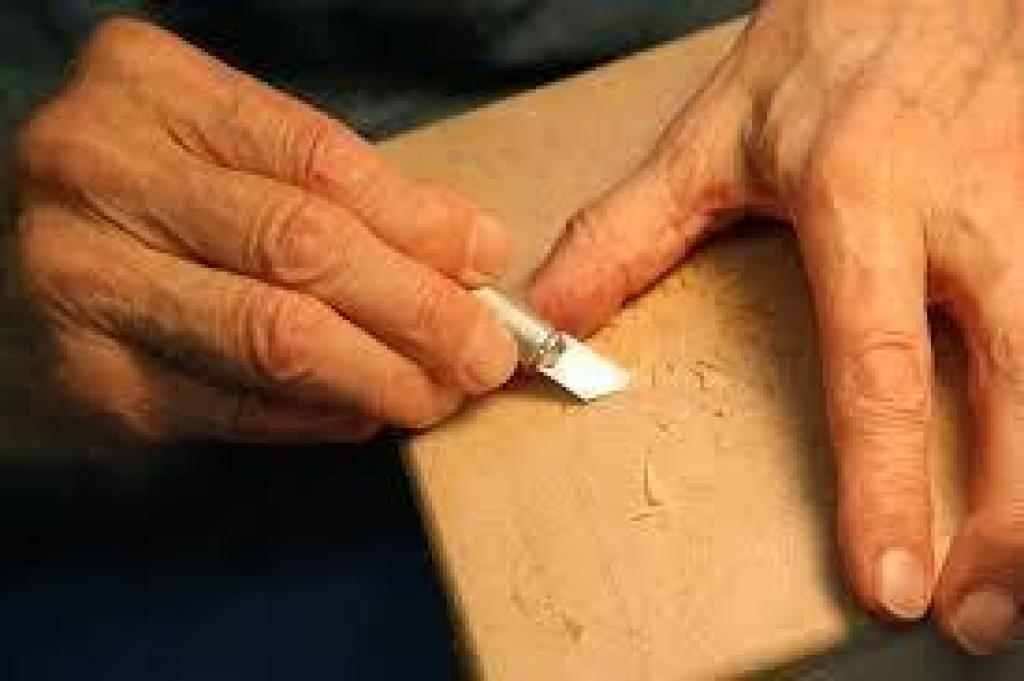
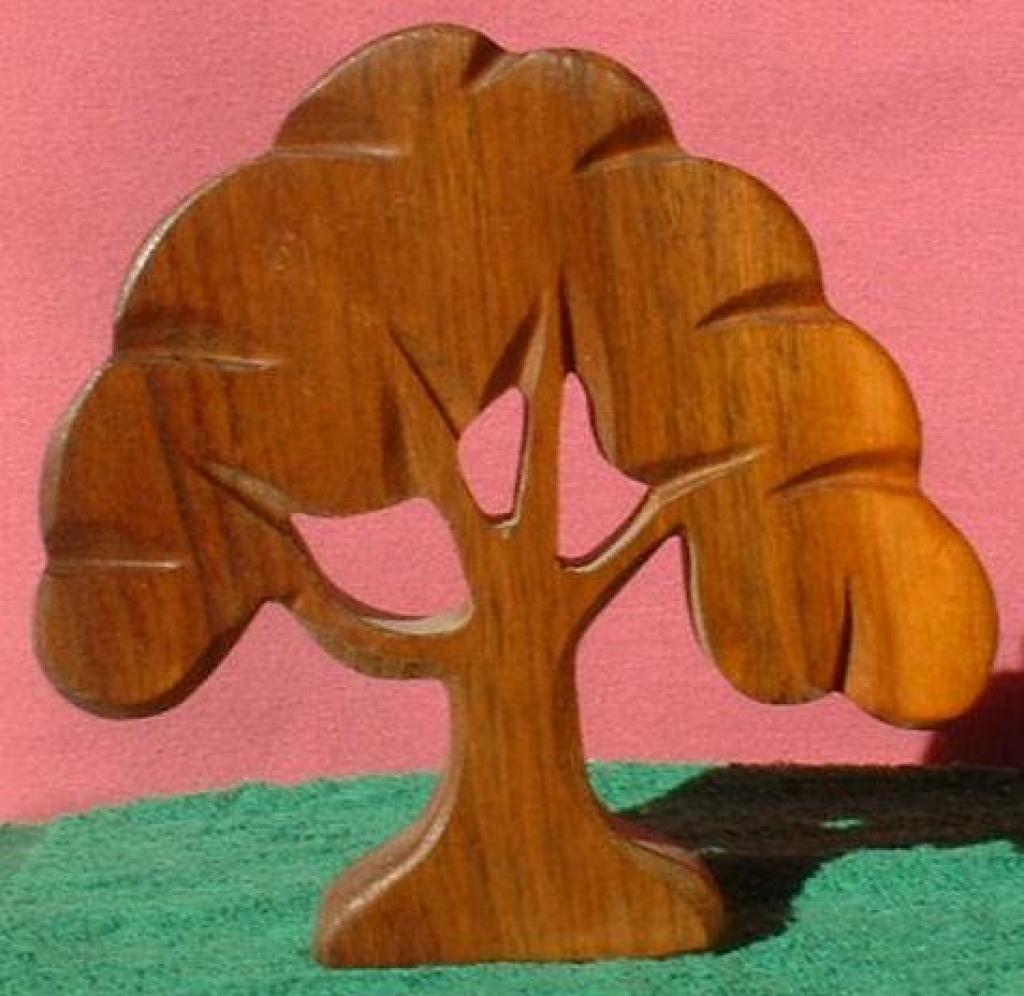
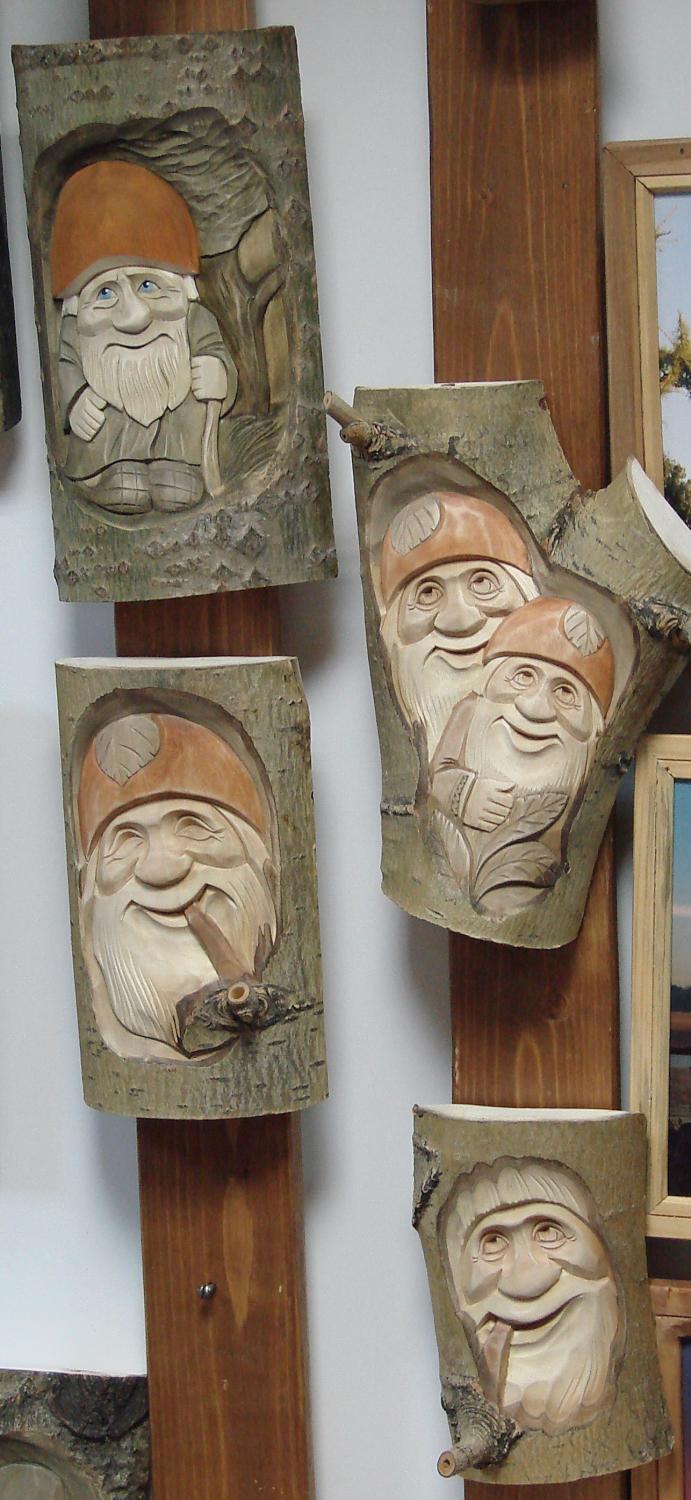
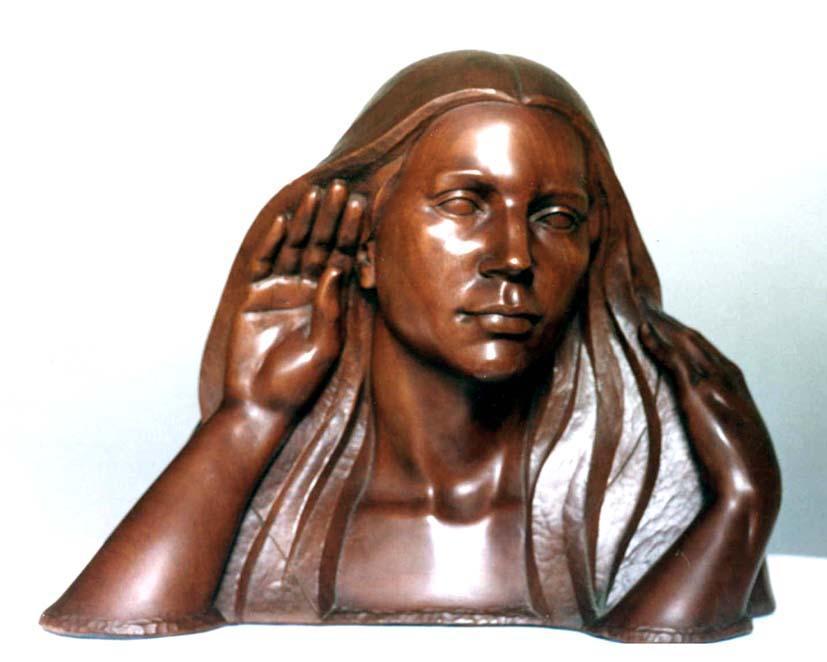
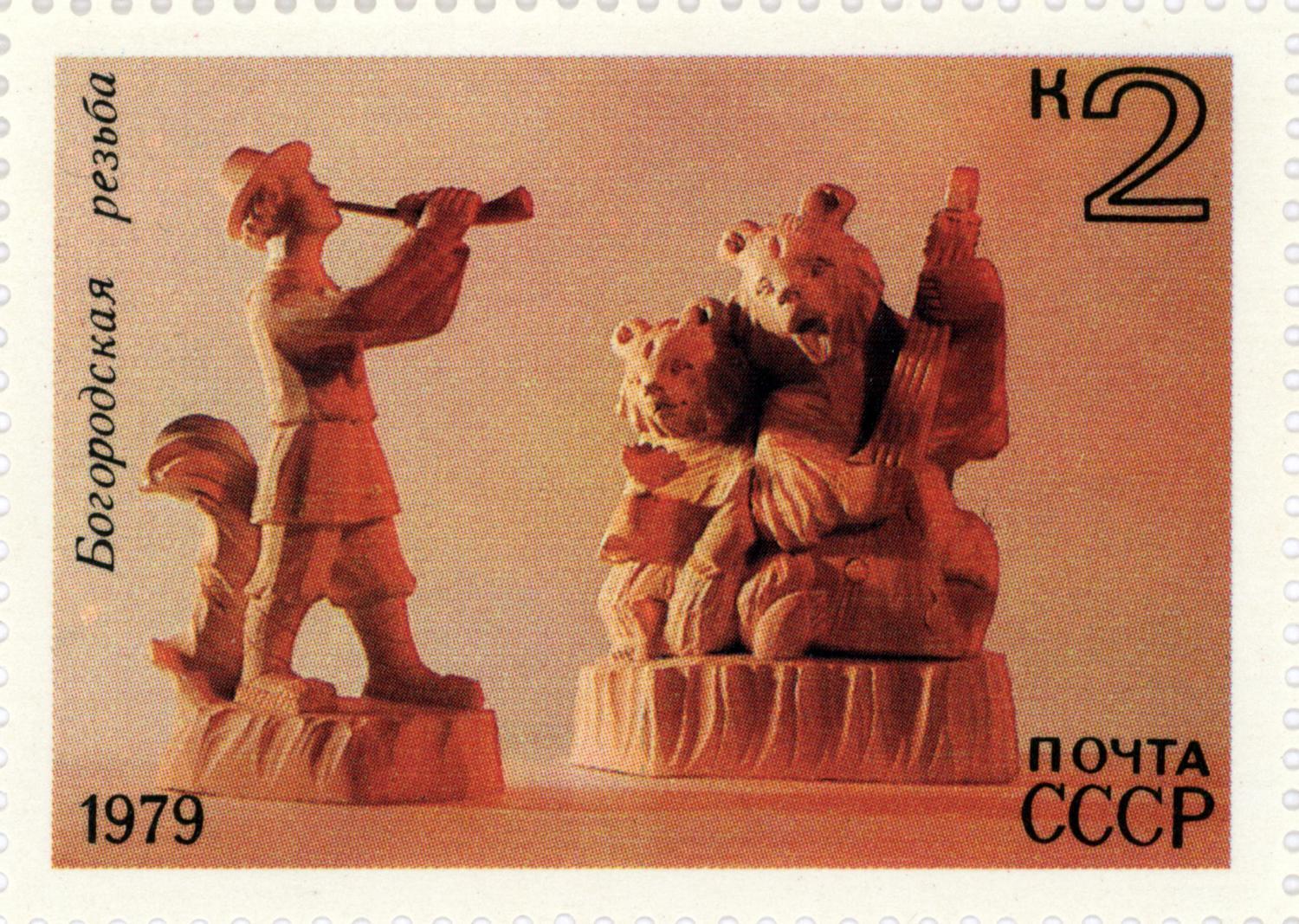
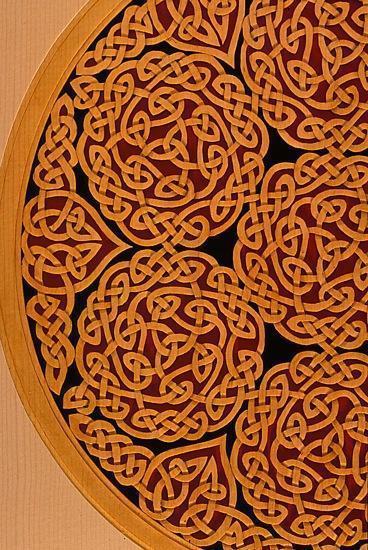
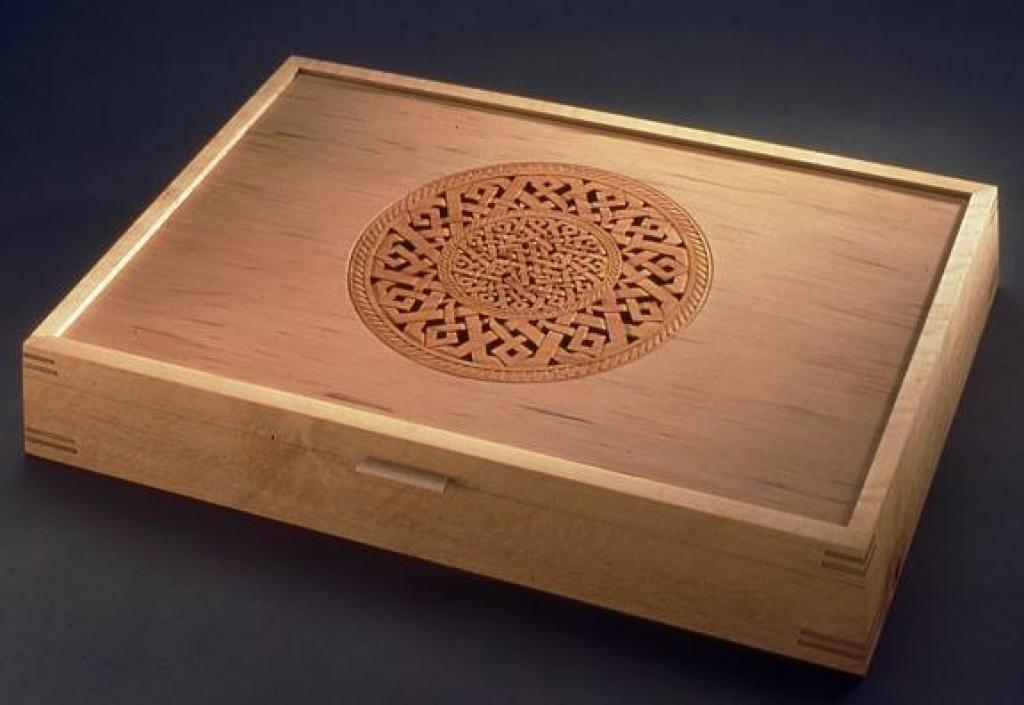
![]()
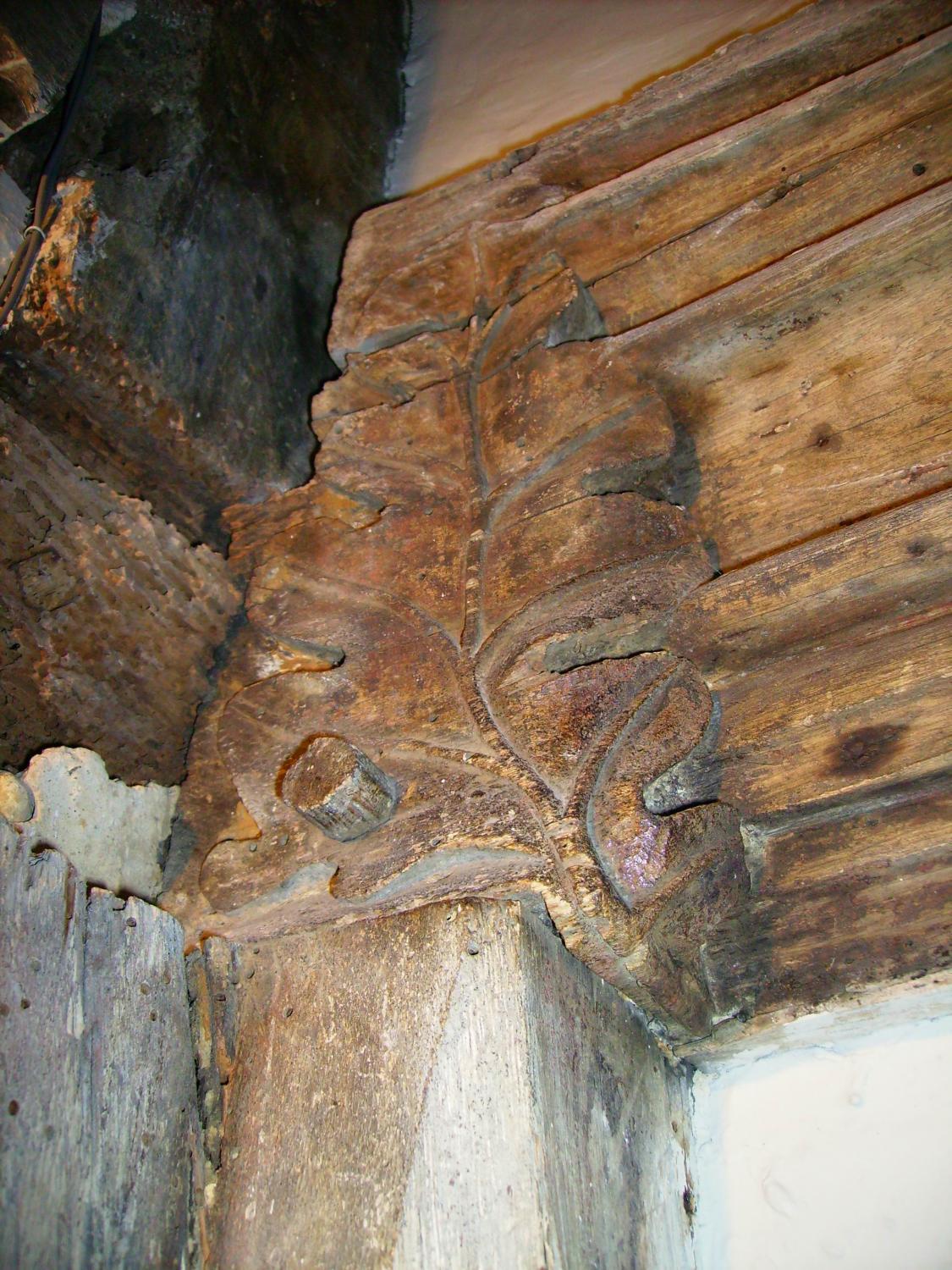
Carving in folk traditions.
Carving on a flat surface in the form of braids and straight lines, cloves, gorodets and kiots, grooves, stars, poppies, fungi, bugs, etc. An example of this ancient carving is the royal place in the Assumption Cathedral.
Development
At the end of the 15th century, the monk of the Trinity-Sergius Lavra Ambrose combined eastern, western and traditional Russian ornaments in his works and had a huge influence on the development of carving in the 15th-16th centuries.
In German
New instruments and German names and terms appeared: gzymzumb, sherhebel, sharheben, foundhtebl etc. In carving and furniture appeared cornices, gzymzy, splengeri, krakshtyns (bracket), transoms, captels, tsyrotic herbs, fruits etc. Craftsmen began to make carvings according to German master's face books - that is, according to samples and drawings.
Technology features
In woodcarving, the master must first of all know the structure of the tree, understand the characteristics of the species. Further, he must take into account the location of the fibers, since the thread goes both along and across them. AT different types threads can be used as a preliminary application of the pattern, and carving "by imagination".
Separate subspecies
It is considered a separate subspecies. Also, a kind of sculptural carving can be considered the art of carving with a chainsaw, which is becoming increasingly popular among both carvers and connoisseurs of beauty.
Recently, the creation of sculptures on various copy-milling machines has also become increasingly popular, the most affordable of which is the Duplicarver.
Famous Russian carvers
K. A. Gogolev, N.I. Maksimov, V.V. Yurov, S. Badaev, M.A. Pronin, A.Ya. Chushkin, A.A. Ryzhov, I.K. Stulov and many others.
Klim Mikhailov is one of the most famous and talented carvers of the second half of the 17th century in Moscow.
Woodworking technology already in the X - XII centuries. was quite developed. Most of the buildings and wooden carvings, showing the considerable skill of carpenters, carvers, turners and joiners, have come down to us already from the 19th century. Thread types
- House (ship) carving
In the 20-30s of the XIX century. in the peasant architecture of the Gorky region and the Middle Volga region, the so-called deaf relief carving spread. This is a carving with an uncut (deaf) background and a high relief of the pattern. She moved to the huts from the Volga ships.
House (ship) carving has a free character. A richly and freely developed floral pattern is usually located throughout the board, the leaves curl in steep counter spirals, they are connected and at the same time separated by images of a multi-petalled flower, visible as if from above, so that all the petals are arranged in a circle or fit into a circle.
Blind relief carving in the 19th and first half of the 20th century. used to decorate furniture - cabinets, tables, mirror frames, cases for floor and wall clocks.
The master carver must be proficient in all types of carving, including those that are used extremely rarely.
- openwork carving
In the middle and in the second half of the XIX century. in Russian wooden buildings, both in rural and urban areas, openwork, sawn carving, performed with a thin file - a jigsaw, became widespread.
Openwork sawn carving adorns the pediments of houses, covers window trims, framing entrances, etc.
openwork carving very effective, it is like wood lace. Many ornamental and decorative motifs of the Russian deaf, relief carving. There are also conditional, generalized, geometrized images of female figures in sawn carving, very similar to images in Russian folk embroidery and lace.
Houses with openwork carvings preserved from the last century can be found in many cities of our country. There are especially many old buildings with carved decoration in the Siberian city of Tomsk.
Folk craftsmen have always had a sense of proportion, therefore, only certain parts of the building were decorated with openwork carvings: window and door frames, chapels, end boards. On sunny days, when the shadow from the slit architraves covers the smooth walls of houses with dark lace, the expressiveness of the openwork carving is enhanced. But even on cloudy days, the details of the carving stand out in a clear pattern against the general background of the wooden structure.
But not only for the sake of beauty, carpenters sewed all kinds of overhead parts to the house. Each of them has a specific practical purpose. For example, a prichelina is a board that covers the ends of the roofs sticking out from under the roof to their ends. moisture did not penetrate, destroying the tree.
The end board, which was nailed to the ends, has the same purpose. log cabin. The window platband closes the joint between the window sash trim and logs. In northern Russian huts, the junction of two chapels was covered with a so-called brush, the lower end of which was decorated with openwork carvings. The so-called towels were also carved - the lower ends of the chapels protruding from under the roof.
Nowadays openwork house carving continues to be used to decorate rural wooden houses, country houses, arbors, sheds, towers on playgrounds.

The main tool used for drilling holes in the board is a brace. They usually drill large holes. It is reliable, proven in work carpentry tool. A ratchet with a ratchet is more convenient, which allows you to lock the cartridge by turning the ring and change the direction of its rotation when clamping or releasing from the drill.
Wood drilling tools:
- brace,
- drill and flat center drills,
- holder with interchangeable flat drills
Holes with a diameter of 10 mm or more are drilled using special flat drills - perok. In addition to ordinary perks, there are universal ones with removable cutting plates on sale. The kit includes 7 drills with a width of 14, 16, 18, 20, 22, 25 and 32 mm. If it is not possible to purchase flat drill bits for wood in a store, you can make them yourself. Make plates with cutting edges from an old saw blade 1.5-2 mm thick, which can be processed quite easily with a file.
When cutting, the canvas is broken according to the applied deep risks. The risks are applied with a scraper, file or some other tool from solid metal. Make a holder from a bolt or rod with a diameter of 8 mm.
Having fixed the rod in a vice, make a cut from the side of the end with a hacksaw for metal. Drill a hole perpendicular to the cut. Punch a hole in the plate at an appropriate distance from the top edge.
Connect the plate to the holder with a rivet. If you want to make the holder universal, cut a thread in its hole and select the appropriate lock screw. The universal holder is constantly clamped in the chuck, and when drilling holes of different diameters, only drill-plates are changed. Before drilling, the center of the future hole is marked with an awl.
Small holes are drilled with a drill or drill. If you are unfamiliar with a drill, look at the picture where it is shown.
Often, openwork carving is called sawn carving, since its technique is based on sawing figured openings in the board. Saws for sawing curved blanks along the outer contour are called rotary or circular. The width of the blade of the circular bow saw is from 4 to 15 mm.
Narrow blades are used when cutting blanks with steep bending lines, and wider blades are used in large ones with smooth, slightly curved or straight contours. Unlike a conventional joiner's bow saw, the blade must be rotated. This makes it possible to make cuts in different directions, almost without changing the position of the saw machine.
The circular bow saw machine can be made by yourself from birch or beech wood. Depending on the size of the workpieces you are sawing and the length of the blades you have, bow saws can have a wide variety of sizes. The circular saw consists of two racks that are inserted into the eyes hollowed out in the thickened ends of the strut. Holes are drilled in the lower parts of the racks, into which the pegs machined on a lathe are inserted. The handles should rotate with some effort.
On the opposite side, at the end of each handle, longitudinal cuts are made into which the canvas is inserted. The tension of the canvas occurs due to the twisting of the bowstring, which tightens the upper ends of the spacers. The bowstring is made from 10-1 2 turns of hemp or linen twine. Instead of twine, a rod with a thread cut at both ends is also used to tighten the upper ends of the racks.
The rod is passed through the holes in the racks and, having put on metal washers, the wing nuts are screwed on both sides. The stands of a homemade circular saw are usually made elongated - this makes it possible to cut curved lines at a considerable distance from the edge of the board. And the saw blade, along with the spacer, is shortened. Such a saw is much more convenient to work with than a standard saw.
All saws basically have three types of teeth: isosceles, rectangular and oblique. If the saw is intended for sawing wood across the fibers, then its teeth should be isosceles triangles, if along, then inclined.
Circular saw, moving along curved lines, crosses the wood fibers at a variety of angles. What kind of tooth shape should a circular saw have? The most versatile was a saw with a rectangular tooth shape, when one of its edges is located at a right angle to the blade. To increase the maneuverability and ease of movement of the circular saw, the set of teeth must be made quite large.
Curvilinear blanks from boards with a thickness of not more than 10 mm are cut with a small round saw or jigsaw.
The main tool for sawing out internal openings in the workpiece is hacksaws with narrow wedge-shaped blades, the so-called triggers. Triggers can also cut blanks along the outer contour. In addition to the usual triggers of different sizes, universal ones with removable canvases are used.
The thickness of the blades of the triggers is 1.5 mm, the length is 325-530 mm, the width at the handle is 20-40 mm, the shape of the teeth is rectangular. The saw is bred through one tooth: even teeth to the right, and odd teeth to the left. They sharpen at random, that is, first through one tooth on one side, and then, turning the canvas, on the other side.
If the hammer could not be bought, it is made by hand from an ordinary hacksaw or an old saw blade 1.5 mm thick. The hacksaw blade is cut so that an elongated sharp wedge is obtained.
If the teeth of the hacksaw you are using have rectangular shape, then the excess metal is cut off from the side of the butt, but if they are of a different shape, then you need to cut off that part of the web on which the teeth are located in order to cut out new teeth on this edge later. You can cut the canvas as follows.
Clamp the blade in a vise between two planks so that only the part that needs to be cut protrudes. Run the tip of the scraper several times along the edges of the boards along the canvas until a sufficiently deep risk is formed. Apply the same risk on the other side of the canvas.
Then, with hammer blows, bend the protruding part of the canvas. Usually the canvas breaks easily exactly at the risk. Align the resulting rough fracture with a file.
Strengthen the canvas with clamps on the workbench. In order not to inadvertently touch the teeth with a file, nail a metal plate 3-4 mm thick along them on a workbench.
First, with several passes of the file, remove the metal from one side of the blade, and then from the other. Usually, before planing, the cross section of the saw has the shape of a rectangle, and after it, it has the shape of an acute triangle or a highly elongated trapezoid.
When sawing, the butt of such a blade is not clamped by wood fibers and the saw moves easily in the cut. The wider the cut formed by the saw, the easier it is to change the direction of the blade. This is especially necessary when cutting sharp bends. To get a wide cut, the saw blade is well bred.
For openwork carving use boards 15-25 mm thick from aspen, pine, birch and alder. Since birch wood is affected by fungi in the open air, carved from it openwork patterns must be covered with a protective layer oil paint. When choosing a material, it is necessary to harvest well-dried boards without cracks, warping and with a minimum number of knots. The smooth surface of the boards is obtained by planing.
Usually any saw pattern consists of several repeating elements. For each of them, you need to cut out a full-size template from thick thick cardboard, textolite, plywood. Soak a cardboard template several times with drying oil and dry for a day. Our drawing shows a pattern of a 5-shaped curl - the most characteristic element of house carving.
When sawing lines with different steepness, different sections of the canvas alternately participate in the work. Very steep lines with a small radius of curvature are cut with the tip of the hammer, that is, its narrowest part.
As the steepness of the line decreases, the middle part of the saw enters the work, and if the line being cut is almost straight, the wide part of the saw located closer to the handle is included in the work. After cutting out the openings on the carved board, eliminate all kinds of flaws and inaccuracies with a narrow-bladed knife and chisels.


- Geometric carving
Geometric carving is diverse in its techniques and the visual effect that it produces. Here, the most used trihedral - notched carving is distinguished, the very name of which suggests that it is based on notches of various sizes, each of which has three faces.
It is followed by a nail-like thread, in the form of recessed holes, and a contour thread. All the variety of cutting on one or another object was achieved by endless combination and variation of these basic techniques.
Currently, geometric carving has switched to new items: caskets, boxes, ladles.

Geometric carving- one of the most ancient types of wood carving, in which the depicted figures have a geometric shape in various combinations. Such a carving is carried out in the form of rectilinear and arcuate elements with a jamb knife and semicircular chisels. This type of carving is popular because of the ease of execution, a small set of tools used in the work. At the same time, this carving does not require, as with relief carving, special knowledge of the theory of drawing. Another advantage of geometric carving is the shallow depth. carved pattern, which does not violate the composition of the product itself.
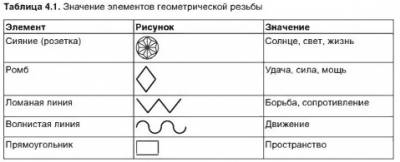
The main types of patterns in geometric carving:
a. Chain
b. snake
in. Honeycombs (squares)
Zigzag snake
d. Honeycombs (diamonds)
e. Christmas trees
- relief carving
Second the most important carving, very ancient in origin and widespread, was flat-relief carving. The very name of the thread shows that it is based on a flat relief.
This means that a pattern, usually free vegetative, is revealed on the surface of a board or household item by choosing, i.e. deepening the background around the future pattern. The background deepens slightly (0.5-1 cm), the drawing itself remains on the same level with the board.
To give it more liveliness and softness, the edges of the pattern thus revealed, mainly images of leaves, berries, birds and animals, are slightly rounded or oval.
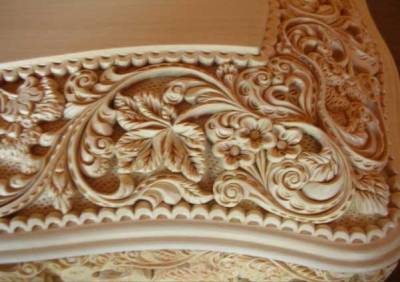
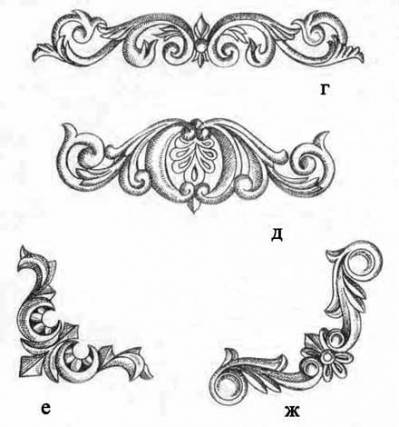
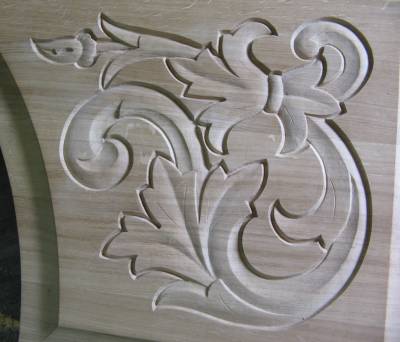
- sculptural carving
Along with flat-relief and high-relief carving (house carving, ship carving), volumetric, sculptural carving has become widespread.
In the old days, carvers were carved by craftsmen - carvers, usually from a whole wooden block, beehives in the form of human or animal figures.
Sculpture- one of the types of fine art, the task of which is to recreate the images of people, animals, significant social and historical events in plastically expressive forms.
- Slotted wood carving
For many centuries, Russian craftsmen with the help of a knife and an ax built wooden palaces, churches, peasant huts, created household utensils decorated with carved patterns. As a result, certain traditions, types and techniques of woodcarving have developed. The most widespread, due to its relative simplicity, was slotted thread.
Slotted wood carving is a carving with a fully selected background. It can be geometric, contour, oval, with good and clean execution it gives the product delicacy and lightness, especially platbands, cornices and fences.

Slotted wood carving can be performed both in the technique of flat-relief carving (with a flat ornament) and in the technique of relief carving. Flat slotted carving was often used to decorate antique Russian furniture. When using such a thread in lockers and screens, a bright fabric is placed under it as a background.
The background in the slotted thread was previously removed with a chisel or saw, but now they have been replaced by an electric jigsaw. In the latter case, the thread is called sawn. Since this operation is mechanized, saw thread is used in the mass production of furniture.
A slotted carving with a relief ornament is called openwork. Such carvings were widely used to decorate baroque and rococo furniture in the late 17th and 18th centuries.
It is easier to cut out an ornament of a slotted or laid on thread than to choose a background with notched contours in a blind thread. The edges of the ornament do not always turn out to be even and clean, therefore, they are rounded off by cutting off a narrow chamfer along the edges or choosing narrow fillets-recesses. House carving does not require especially careful execution, since it often looks from afar.
house carving mainly performed by sawing and drilling. The traces left by the tool are rarely cleaned, wood scratches are often not taken into account. However, many carpenters try to make such carvings as clean as possible.
Holes in the workpiece or in the part are drilled or cut with round chisels, small and large, depending on where the part should be. To protect the part from chipping, its back side should be pressed tightly against some smooth board.
Saw through the parts in this order. First of all, a hole is drilled, then a jigsaw or a hacksaw is inserted into it and sawed through according to the risks. The workpiece can be laid on a workbench and sawn from top to bottom, but it is better to arrange a special stand made of a thick board about a meter long.
Overhead wood carving- this is an ornament made with a slotted carving and glued or nailed onto a finished background, for example, on a platband board or on another detail.
The applied thread with this method of execution is clearer than the blind thread and looks much better. In this case slotted thread must be done as cleanly as possible. It is not recommended to chamfer reverse side details, as it may give the impression that the thread is torn off from the main background.

(also carving is one of the types of artistic processing of wood along with sawing, turning), as well as art in general (this is an old folk craft).
Encyclopedic YouTube
-
1 / 5
It does not have a strict classification, since different types of thread can be combined in the same product.
It is conditionally possible to distinguish the types of thread:
- through thread (this includes saw and slotted thread)
- blind thread (all subspecies of embossed and flat notched thread)
- sculptural carving
- house carving (it is a separate direction, since it can combine all three of the above types).
- Chainsaw carving (Performing mostly sculptural carving with only a chainsaw.)
The conditional classification of thread types is as follows:
through thread
through thread is divided into proper end-to-end and consignment note, has two subspecies:
- Slotted carving - (through sections are cut with chisels and chisels)
- Saw thread (actually the same, but such sections are cut with a saw or jigsaw).
A slotted or sawn thread with a relief ornament is called openwork.
Flat serrated thread
Flat carving is characterized by the fact that its basis is a flat background, and the elements of the thread go deep into it, that is, the lower level of the carved elements lies below the background level. There are several subspecies of such a thread:
- contour thread - the simplest, its only element is a groove. Such grooves-grooves create a pattern on a flat background. Depending on the chosen chisel, the groove can be semicircular or triangular. The semicircular one is cut with a semicircular chisel, and the triangular one is cut with a corner cutter, an angular chisel or a knife in two steps.
- stapled (nail-like) carving - the main element is a bracket (outwardly it looks like a trace left by a nail when pressed on any soft material, hence the name nail-like) - a semicircular notch on a flat background. Such a notch is made a semicircular chisel in two steps: first, the chisel is deepened into the tree perpendicular to the surface, and then at an angle at some distance from the first notch. The result is the so-called bracket. A set of such brackets of different sizes and directions creates a picture or its individual elements.
- geometric carving:
- trihedral thread
- two-sidedwashing thread
- four-sided washout thread
- black lacquer carving - the background is a flat surface covered with black lacquer or paint. How grooves are cut in the contour carving on the background, from which the drawing is built. The different depths of the grooves and their different profiles give an interesting play of chiaroscuro and contrast between the black background and light cut grooves.
relief carving
Relief carving is characterized by the fact that the carving elements are above the background or on the same level with it. As a rule, all carved panels are made in this technique. There are several subspecies of such a thread:
- flat-relief carving with a pillow background - can be compared with contour carving, but all the edges of the grooves oval, and sometimes with varying degrees of steepness (more sharply from the side of the picture, gradually, gently sloping from the side of the background). Due to such littered contours, the background seems to be made of pillows, hence the name. The background is on the same level as the drawing. Relief carving with selected background - the same carving, but only the background is selected with chisels one level lower. The contours of the picture are also oval.
- Abramtsevo-Kudrinskaya carving (Kudrinskaya) - originated in the Abramtsevo estate near Moscow, in the village of Kudrino. Vasily Vornoskov is considered the author. The carving is distinguished by a characteristic "curly" ornament - curly garlands of petals and flowers. The same characteristic images of birds and animals are often used. As well as flat-relief, it happens with a pillow and a selected background.
sculptural carving
A distinctive feature is the presence of sculpture - images of individual figures (or groups of figures) of people, animals, birds or other objects. In fact, it is the most difficult type of carving, since it requires the carver to have a three-dimensional vision of the figure, a sense of perspective, and maintain proportions.
It is considered a separate subspecies. Bogorodskaya carving. Also, a kind of sculptural carving can be considered the art of carving with a chainsaw, which is becoming increasingly popular among both carvers and connoisseurs of beauty. The popularity is easy to explain. Carving with a chainsaw is, first of all, an action, a performance, a show. Increasingly, festivals, competitions, demonstration performances by chainsaw carving masters at public events, presentations, and exhibitions began to be held. Unlike other genres of wood carving, the viewer not only sees the end result of the master's painstaking and long work, but also visually participates in the process of creating a sculpture. Recently, the creation of sculptures on various copy-milling machines has also become increasingly popular, the most affordable of which is the Duplicarver.











Chocolate biscuit: the secrets of cooking in a slow cooker and oven
Chemical composition and nutritional value
Apple chips at home
Braised cabbage with white beans, recipe
How to reduce the ass, hips and stomach at home?